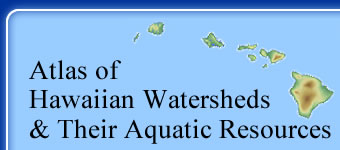
Key to Methods - Watershed Features
Hawaiian Name Meaning: A description or translation of the meaning of the Hawaiian name. The translation was done by Darrell Kuamo'o (DAR Hilo) using the Place Names of Hawaii by Mary Kawena Pukui, Samuel H. Elbert, and Esther T. Mookini and the Hawaiian Dictionary by Mary Kawena Pukui and Samuel H. Elbert.
Maximum Elevation: This is the maximum elevation of the watershed.
Watershed Cluster Type: This is a category with range of 1 to 8 that identifies geomorphologically similar watersheds (Parham, 2002). A total of 150 watersheds were grouped into categories in the original work, and any additional watersheds presented in this Atlas were classified by using the key.
Zoning: Zoning information was downloaded from the State of Hawaii’s Office of Planning Statewide GIS Program website (http://www.hawaii.gov/dbedt/gis/). The State of Hawaii zones all land into four districts, each of which has its own regulatory agency, laws, administrative rules, and procedures. The zones are urban, rural, agricultural, and conservation.
Land Stewardship: Land stewardship information comes from the Hawaii Gap Analysis Program (GAP) (http://www.higap.org). We combined some of their categories into the more general categories of military, federal, state, Hawaiian homes, county, The Nature Conservancy of Hawaii, and other private landowners. Land Stewardship is not necessarily land ownership; instead, stewardship reflects who is taking care of the land.
Land Management Status: These data also come from the Hawaii GAP. They represent 4 levels of biodiversity protection. The highest involves permanent biodiversity protection. The next highest level represents lands that are partly managed for biodiversity but have multiple use mandates that may be inconsistent with biodiversity protection (e.g., game hunting areas). The next level down in biodiversity protection includes lands that have some protection but are currently unmanaged, and the lowest level is lands that are unprotected.
Land Use/Land Cover: Land use and land cover information was downloaded from National Oceanic and Atmospheric Administration (NOAA) Coastal Services Center (http://www.csc.noaa.gov/crs/lca/hawaii). Data from the Costal Change Analysis Program (C-CAP) were used to classify land cover. The information is based on images collected in 2000 for all islands except Hawaii where the information was collected in 2001. Land cover categories are:
- High intensity developed: urban land cover with greater than 75 percent impervious surface.
- Low intensity developed: urban land cover with greater than 25 percent and less than 75 percent impervious surface.
- Cultivated land: area under active agriculture.
- Evergreen forest: forest without a pronounced seasonal dormancy period.
- Scrub/Shrub: woody vegetation less than 20 feet tall.
- Grassland: both managed and unmanaged grasslands.
- Emergent Wetland: wetland-rooted emergent species.
- Unconsolidated shoreline: tidal flats, shoals, and intertidal areas.
- Bare land: bare exposed rock, sand, and soil.
The addition of the category Estuarine signifies that the area has species commonly found in tidally influenced areas, and the addition of the term Palustrine signifies that the area has species commonly associated with nonflowing freshwaters.